Hass Revision
Ecosystems
An ecosystem is an autonomous system of living organisms that interact with each other and the non-living components of an environment.
The dynamics of an ecosystem is how energy is transferred amongst the system and throughout
The structure of an ecosystem is characterised by the organisation of producers then consumers, and finally decomposers
Lithosphere: The solid part of the Earth’s crust, consisting of rocks and soil
Hydrosphere: All of Earth’s water bodies, including lakes, rivers, streams, oceans, ground
water, and ice caps
Atmosphere: Layers of gas surrounding the Earth
Biosphere: Consists of living things including plants, animals, bacteria, fungi, etc
Abiotic vs Biotic
Abiotic factors - Non-living components that are influential in controlling the function of the ecosystem
Air, sun, soil, water, and basic compounds and elements of the environment
Classified as climatic (temp, wind, rain) or edaphic (soil, minerals, topography)
Biotic factors - Living components including the association of many different species that inhabit the same areas
Animal, plant, and microbial communities
Divided into trophic levels within a food chain:
Autotrophs (Core of all biotic systems) - self-feeding
Heterotrophs - consumers
Saprotrophs - decomposers

Components of an ecosystem
The 5 components of an ecosystem are:
Climate
Climate → Fauna: Determines the type of food available, food supplies, and adaptations of the fauna. Rising temps can cause habitat loss and possible uninhabitable, forcing wildlife to migrate.
Climate → Vegetation: Climate change causes droughts, bushfires, floods, etc affecting flora biodiversity. Precipitation nurtures plant growth but in extreme levels, can disturb plant growth.
Climate → Landforms: Controls Gradational processes such as weathering, mass movement, erosion, transportation, and deposition.
Climate → soil: Climate affects soil as it controls water movement through soil and the breakdown of humus. This affects depth and drainage.
Vegetation (plants)
Vegetation → fauna: Flora provide food and shelter to fauna as well as the control of adaptations
Vegetation → Climate: Flora affects the carbon dioxide content in the atmosphere, leading to a cooler climate. They also create microclimates which is the climate of a very small area.
Vegetation → landforms: Flora improves the stability of landforms, with their roots providing extra cohesion to landforms.
Vegetation → soil: Flora provides energy and nutrients to the soil by producing organic matter such as humus and nutrients
Fauna (animals)
Fauna → Vegetation: Herbivores eat flora as a part of their diet. Fauna can disperse seeds and pollinate flora.
Fauna → Climate: Fauna produce methane which adds to the greenhouse gasses in the atmosphere, contributing to climate change.??
Fauna → Landforms: Fauna can destroy landforms, causing them to break and change shape.
Fauna → Soil: Fauna like rabbits and moles burrow in soil and aerate it. Fauna can also ingest and transform organic matter into decomposable forms.
Soils
Soil → Fauna: Soils can provide homes and nutrients for fauna
Soil → Vegetation: Soil controls the type and growth of flora and provides mineral supply. If the soil gains more nutrients, the flora will grow more abundantly
Soil → Climate:
Soil → Landforms:
Landforms
Landforms → Fauna: Different landforms provide a variety of habitats for animals to live and evolve in.
Landforms → vegetation: The roughness of landform surfaces provides higher vegetation diversity while the slope promotes and increases the vegetation cover.
Landforms → Climate: High land modifies temperatures and can create orographic rainfall. Landforms can also channel or block winds
Landforms → Soil: Soils on the side of hills tend to be shallow, due to erosional losses. Soils on the tops of hills tend to be deep, but lighter in colour. Soils in the valleys tend to be deeper, and darker.
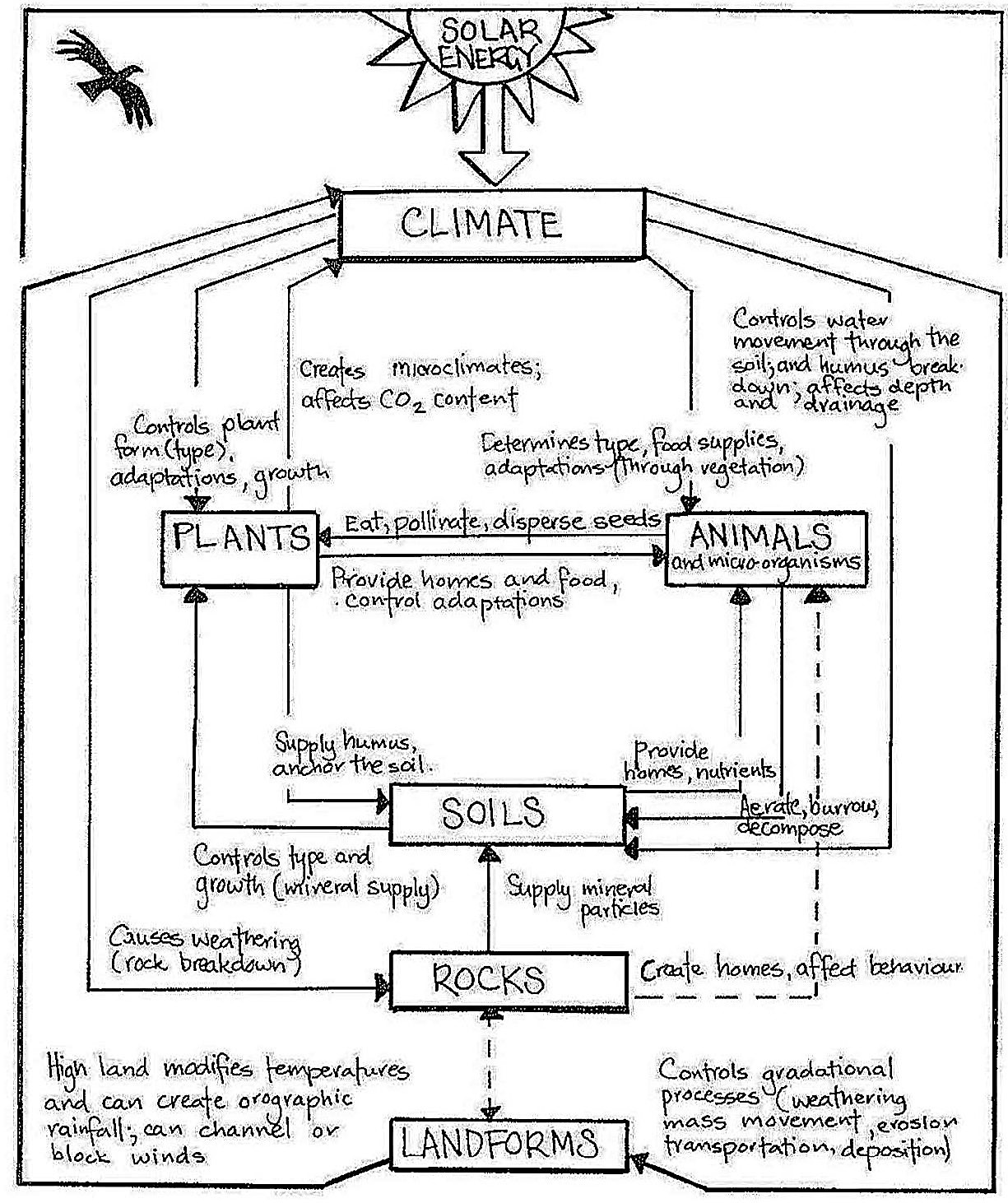
Biomes
Biomes are large areas characterised by the dominant vegetation in the area.
Biomes are large geographic regions defined by their climate, dominant vegetation, and wildlife, such as deserts or rainforests, and encompass multiple ecosystems within them. ecosystems are smaller, specific areas within biomes where living organisms interact with each other and their physical environment, such as a coral reef. Ecosystems focus on the detailed interactions between organisms and their environment within an area.
Types of biomes
Forest and woodland biomes
Forest and woodland biomes are dominated by trees. Forests have very tall trees that are denser forming a closed canopy. Woodlands have smaller trees separated by some distance, forming an open canopy. The higher the rainfall, the taller the trees and the more closely spaced they will be (increased productivity).
Tropical Forests:
Temperature: Very hot temperatures, remaining warm and stable throughout the year. The temperature usually ranges from 20°C to 30°C with minimal seasonal variation.
Precipitation: High average annual rainfall (>1500 mm per year), distributed evenly throughout the year, with no distinct dry season.
Seasonality: Little to no seasonality, consistent conditions year-round.
Vegetation: Trees grow over 40 meters high and form a continuous canopy. Includes African mahogany, teak, and balsa. Understorey contains saplings, palms, and ferns, growing to about 15 meters due to limited light. Forest floor has sparse vegetation, including palms, bamboo, ferns, orchids, and mosses. It is covered in decomposing leaves and branches, creating a shallow layer of humus.
Soil: Despite high productivity, the soils are relatively infertile due to heavy rainfall and leaching of nutrients.
Biodiversity: The most biodiverse ecosystems on Earth, vast range of plant and animal species. The multi-storey arrangement supports a variety of life forms.

Temperate Forests:
Warm:
Temperature: Hot summers and cool to mild winters. The climate is generally moderate, with temperatures varying significantly between seasons but not reaching extremes.
Precipitation: High average annual rainfall (>1500 mm per year). Rainfall is evenly distributed throughout the year.
Seasonality: Distinct seasons, with hot summers and cooler winters. The presence of rainfall year-round means that the environment remains relatively moist throughout the year.
Vegetation: Dominated by broad-leafed evergreen trees adapted to the plentiful and evenly distributed rainfall. Northern hemisphere: Oaks, laurels, and camphor. Southern Hemisphere: Southern beech and eucalypts.
Soil:
Biodiversity: Rich diversity of plant and animal species. The evergreen nature of the trees means that the forests remain lush and green year-round, providing a stable habitat for various species.
Cool:
Temperature: Cool temperate forests are found in regions with very cold winters and milder summers. The temperature varies significantly, with warm summers and harsh, cold winters.
Precipitation: High annual rainfall, (>1500 mm). This precipitation is essential for sustaining the forest, particularly during the growth season in spring and summer.
Seasonality: Experience 4 distinct seasons. Winters are very cold, with trees losing their leaves and going dormant. Spring and summer bring warmer temperatures, prompting new growth.
Vegetation: Dominated by deciduous trees. Includes oak, maple, elm, ash, birch, and chestnut.
Soil:
Biodiversity: Diverse array of species, although the biodiversity is generally lower than in tropical or warm temperate forests.

Taiga Forests
Temperature: Cold winters and moderately warm summers. Winter temperatures can drop significantly, often well below freezing, while summers are relatively mild. Growing season lasts 130 days.
Precipitation: Receives around 400 - 1000 mm of precipitation per year, which includes both rain and snow. Summers are wet, but the overall annual precipitation is relatively low compared to other forest biomes.
Seasonality: distinct seasons, with long, cold, and dry winters, and short, warm, and wet summers. The growing season is brief due to the harsh climate.
Vegetation: Dominated by cold-tolerant evergreen coniferous trees such as pine, fir, and spruce. Trees well-adapted to the cold and poor soil conditions, with needle-like leaves that minimise water loss and can survive under the snow during winter. The forest is dense and dark, with limited undergrowth due to the low light penetration and poor soil quality.
Soil: Thin, nutrient-poor, and acidic
Biodiversity: Relatively low biodiversity compared toother forests. However, it is home to a variety of cold-adapted species, including large mammals like bears, and wolves. The harsh climate and soils limit the variety of plant species, but the coniferous trees are well-suited to the environment, creating a stable ecosystem.

Woodlands
Temperature: Savannah woodlands are found in tropical regions, experiencing hot, wet summers and warm, dry winters.
Mediterranean woodlands are located in regions experience warm to hot, dry summers and cool to mild, wet winters.
Precipitation: Moderate rainfall (700 - 1200 mm) per year. This rainfall is often seasonal, with distinct wet and dry periods.
Sesonality: Savanna Woodlands have pronounced wet and dry season. The summers are hot and wet, while the winters are warm and dry.
Mediterranean Woodlands have distinct seasons, with hot, dry summers and cooler, wetter winters.
Vegetation: Woodlands are dominated by evergreen species (oaks, olicies, eucalyptus), adapted to seasonal drought through features like waxy, leathery leaves that reduce water loss, and thick bark that insulates against heat and protects from fire. The vegetation is often sparse, with widely spaced trees allowing sunlight to reach the ground, promoting the growth of grasses and shrubs.
Biodiversity: Support a variety of species adapted to the seasonal availability of water. Often influenced by the specific climate of the region, with Mediterranean woodlands supporting different plant and animal communities than savanna woodlands.
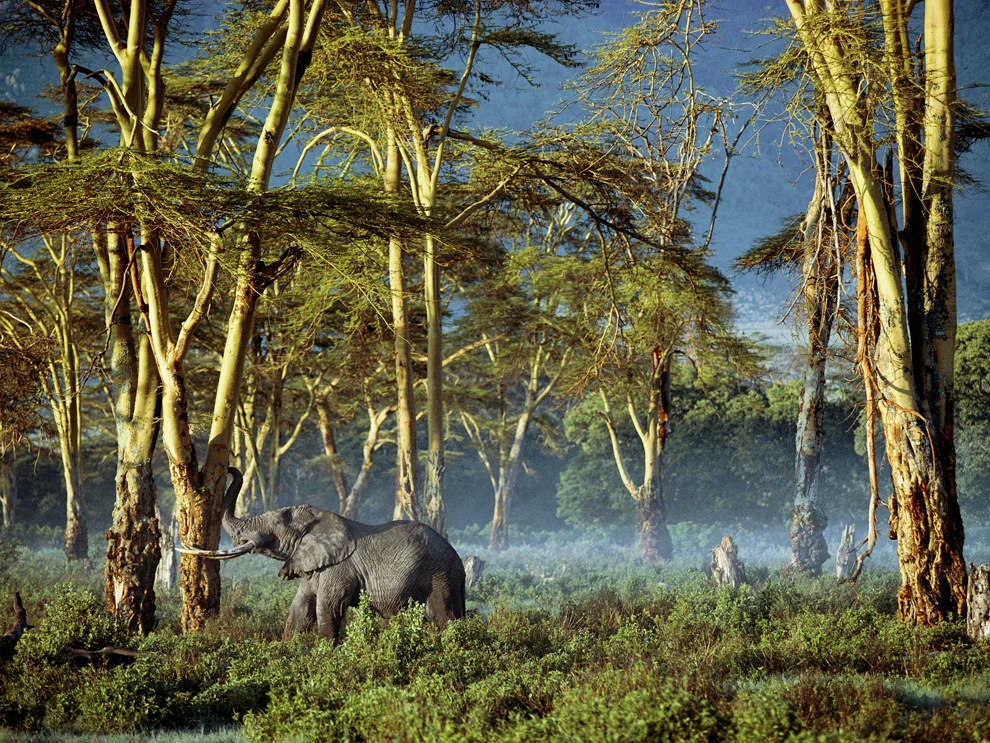
Grassland biomes
Grassland areas are found in the moderately drier parts of the world. The two main divisions of grasslands include savanna grasslands and temperate grasslands.
Savanna grasslands
Temperature: Relatievly hot, wet summers and warm, dry winters. The climate remains warm year-round (20°C to 30°C)
Precipitation: Savannas receive between 500 - 1000 mm of rainfall annually. The rainfall is seasonal, with most of it occurring during the hot summer months, while winters are generally dry.
Sesonality: Distinct wet and dry seasons. The wet season coincides with the hot summer months, while the dry season coincides with the cooler winter months.
Vegetation: Dominated by grasses, which vary depending on the amount of rainfall and soil conditions in the area. In drier regions, Rhodes grass and red oat grass are dominant. In the wetter areas, star grasses are dominant. Trees and shrubs are sparse and often widely spaced, allowing grasses to dominate the landscape.
Soil: Typically porous, allowing for rapid drainage of water. This leads to a thin layer of humus, which is the organic portion of the soil that provides nutrients to vegetation. However, the thin humus layer means that the soil is not particularly nutrient-rich.
Biodiversity: Support a diverse range of plant and animal species, particularly those adapted to the seasonal availability of water. The grasslands are home to large herbivores (elephants) as well as predators. The vegetation primarily consists of drought-resistant grasses and occasional trees.

Temperate grasslands
Temperature: Hot summers and cold winters, with significant temperature variations between seasons. Summer temperatures can be high, while winters can be harsh, cold.
Precipitation: Moderate seasonal rainfall (200 - 350mm)
Sesonality: Distinct seasons, with warm to hot summers and cold winters.
Vegetation: The type and height of grasses in temperate grasslands vary depending on the amount of rainfall. Wetter regions = taller grasses (prairies), while drier regions = shorter grasses (steppes). Vegetation is primarily composed of drought-resistant grasses, with very few trees or shrubs.
Soil: Deep, dark, and highly fertile. The upper layers are nutrient-rich, benefiting from the growth and decay of deep, multi-branched grass roots.
Biodiversity: Support a variety of plant and animal species, particularly those adapted to the seasonal climate and the open, grassy environment. The fertile soils support a wide range of grasses and herbaceous plants, while large herbivores thrive in this habitat. Predators also inhabit these regions, depending on the availability of prey.
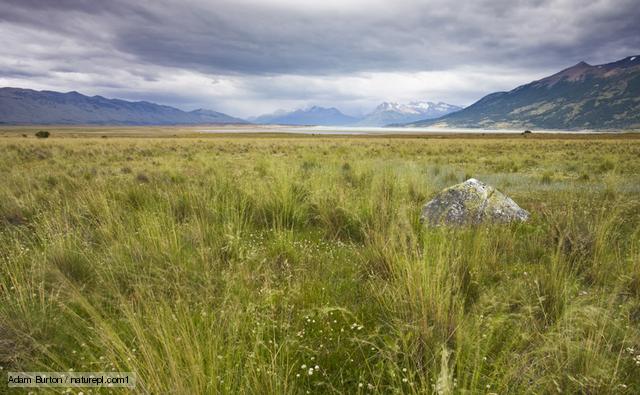
Desert biomes
Temperature: Hot deserts experience extreme temperature ranges due to their inland locations with daytime temperatures being very high (>40°C). Nighttime temperatures can drop significantly, sometimes to freezing levels, due to the lack of moisture and vegetation that would otherwise retain heat.
Precipitation: Very little rainfalll (<250 mm) per year. The low precipitation levels, combined with high evaporation rates, result in extremely arid conditions.
Sesonality: Hot deserts have marked temperature variations between day and night, and between seasons, although the seasons themselves are generally dry. The extreme heat during the day contrasts with much cooler nights, and there is little seasonal variation in precipitation.
Vegetation: Desert vegetation is typically sparse, stunted, and widely spaced, having adapted to the limited moisture and poor soil conditions. Plants in deserts are often xerophytes, which have evolved to survive severe drought conditions. They are categorized into four groups:
Drought Evaders: Plants with short life cycles (Sturt's desert pea) which only grow when there is sufficient rainfall.
Drought Escapers: (Australian ghost gum) Root systems that can access alternative water sources, such as underground water.
Drought Resisters: (cacti) Reduce water loss through features such as reduced leaf surface area.
Water Conservers: Succulents with fleshy stems that store water, allowing them to survive during extended dry periods.
Soil: Poorly developed and very shallow. Due to high evaporation rates that exceed precipitation, minerals are often drawn upward, making the soil salty, lacking in humus, and generally infertile.
Biodiversity: Lower biodiversity compared to more temperate or tropical ecosystems. However, the species that do inhabit deserts are highly specialised and well-adapted to the harsh conditions (xerophytic plants, animals that have evolved to survive with minimal water and extreme temperatures).
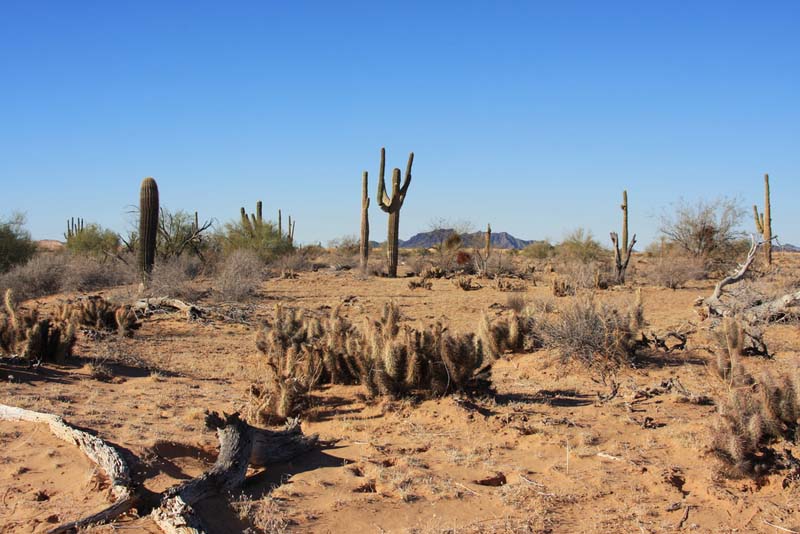
Tundra biomes
Temperature: The tundra experiences extremely low temperatures, especially during the winter (-34°C). Summer temps are relatively mild (12°C).
Precipitation: Very little precipitation (150 to 250 mm per year). Most fall as snow.
Seasonality: Very short growing season (50 to 60 days during the summer). During this brief period, temps rise enough to allow plant growth, although conditions remain harsh.
Vegetation: Treeless landscape, vegetation adapted to the cold climate and poor, shallow soils. About 1,700 species of plants in the tundra (low shrubs, sedges, mosses, grasses). These plants are adapted to the strong winds and cold temps, growing in dense clusters to resist the cold.
Soil: Formation is slow, and the soil is thin, nutrient-poor. key feature of tundra soils is permafrost, a layer of permanently frozen subsoil that underlies the surface. The permafrost consists mostly of gravel and finer materials. During the brief summer, the upper layer of soil may thaw, leading to the formation of bogs and ponds that provide moisture for the vegetation.
Biodiversity: Supports a variety of specially adapted plants and animals. The low biodiversity compared to other biomes is offset by the resilience and adaptability of the species that inhabit this region (Caribou, Arctic foxes, migratory birds).
Alpine biomes
Temperature: Located at high altitudes where temperatures are cold year-round. Winter temps are generally below freezing. Summer temps can rise to around 10°C
Precipitation: Rain often falling in the form of snow.
Seasonality: Significant seasonal variations in temperature, with very cold winters and relatively cool summers. The growing season is short.
Vegetation: The harsh climate limits the types of plants that can survive. Most vegetation consists of low perennial groundcover, small-leafed shrubs, and heaths. These plants are adapted to the cold and wind by growing close to the ground, which helps them conserve heat and reduce exposure to harsh condition.
Soil: Soils in alpine regions are thin, sandy, and rocky, resulting from the slow decomposition of organic matter due to the cold temperatures.
Biodiversity: Tend to have lower biodiversity compared to lower-altitude biomes due to the extreme conditions. The species that do inhabit these regions are highly specialised and adapted to the cold, low-oxygen environment.

Spatial distribution
Spatial distribution is the arrangement of a phenomenon across the Earth's surface
The spatial distribution of the different biomes depends on the biomes latitude. The higher the latitude, the lower the amount of sun reaches the biome, therefore not providing the sufficient amount of resources needed for the growth of plant life.
Climate
Climate is the long-term average of weather patterns in a region including factors of temperature and rainfall.
Weather refers to short-term atmospheric conditions, such as daily changes in temperature, precipitation, and wind.
Koppens climate classifications
The Koppens climate classification is a system which categorises climate zones throughout the world based on local vegetation.
The system divides climates into 5 main climate groups, each being divided based on seasonal precipitation and temperate patterns:
A (tropical): Warm temperatures year-round, with an average temperature above 18°C.
B (arid): Decent precipitation during most of the year.
C (temperate): Moderate temperatures, with distinct seasons.
D (continental): More extreme temperature variations between seasons, with cold winters.
E (polar): Cold temperatures year-round, with short, cool summers.
Climate graph
A climate graph combines both line graphs and column graphs to show the average rainfall and temperatures experienced at a place throughout the year.
LAPDOG
Latitude: Refers to the place's position in relation to the Equator.
Places closer to the Equator experience warmer climates due to more direct sunlight.
Polar regions, further from the Equator, receive less direct sunlight and are generally cooler.
The angle of sunlight affects the intensity of heat received.
Altitude: The height of a location above sea level
Higher altitudes typically have cooler climates because temperature decreases with elevation.
Low-lying areas like valleys are warmer compared to mountainous regions at higher elevations.
Temp falls 6.5 degrees every 1000 metres.
Prevailing Winds: The global wind patterns that distribute heat and moisture around the Earth.
Winds move warm air towards higher latitudes and cooler air towards lower latitudes.
The movement of warm air rising and cool air sinking creates circular air patterns. Winds from colder regions contribute to cooler climates, while winds from warmer regions bring higher temperatures.
Winds passing over oceans can carry moisture, leading to increased rainfall in coastal areas.
Distance Inland: How far a region is from the coastline.
Land heats up and cools quicker than the ocean
The temp of oceans and seas remain about the same throughout the year.
The further from the coast an area is, the more extreme its climate is likely to be
During summer, winds from oceans cool nearby places while during winter, winds from oceans warm nearby places
Places closer to the sea have milder temps and higher rainfall while places further away experience more extreme climate.
Ocean Currents: Cyclic movements of ocean water that flow through the Earth's oceans.
Ocean currents can significantly impact the temperature and precipitation of coastal regions.
Warm currents flowing from the equator increase temps and rainfall in areas it passes
Cold currents moving towards the equator reduce temps and rainfall in areas it passes.
Oceans hold more heat than the atmosphere and land
Great Mountain Barriers: Physical features such as mountains that affect climate by influencing precipitation patterns.
Mountains act as barriers to air movement, impacting precipitation levels on their windward and leeward sides.
The windward side, facing prevailing winds, receives more rainfall as moist air is forced to rise, cool, and condense into precipitation.
The leeward side, sheltered from prevailing winds, experiences drier conditions known as rain shadows.
The uplift of air over mountains leads to cloud formation and rainfall on the windward side, while the leeward side remains dry due to the descending, warmer air.
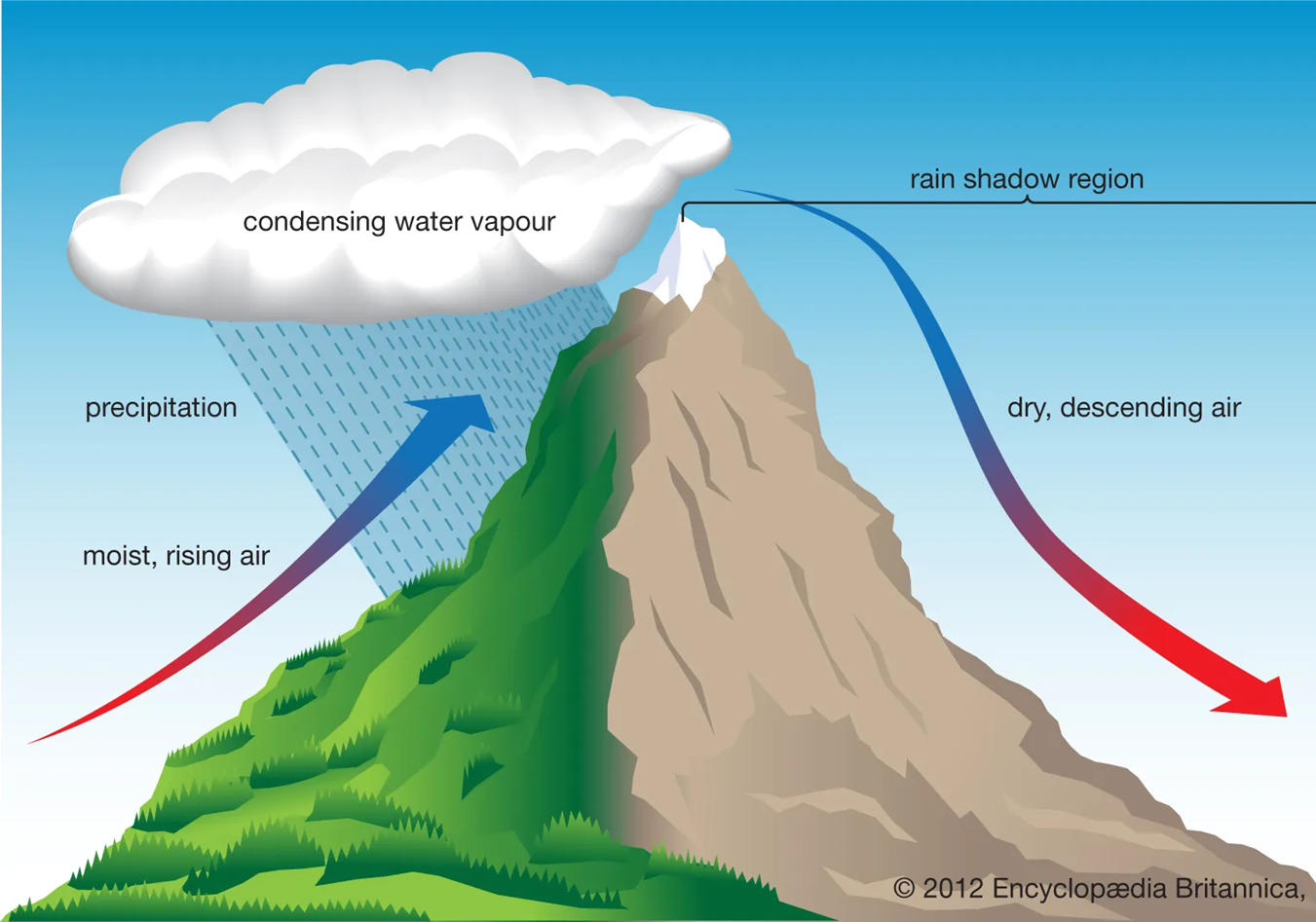
 Knowt
Knowt
